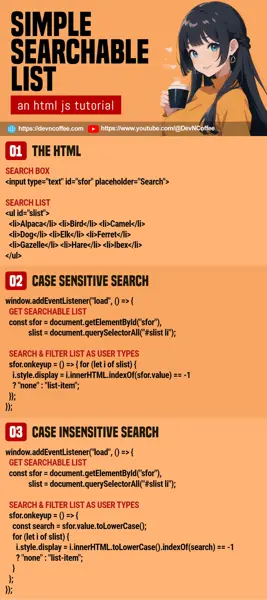Need to add a “search feature” to a list on your website? A “simple version” can literally be done with like… less than 15 lines of Javascript code. No kidding – Let’s go!
CODE DOWNLOAD
I have released this under the MIT license, feel free to use it in your own project – Personal or commercial. Some form of credits will be nice though. 🙂
VIDEO TUTORIAL
EXAMPLE 1) JAVASCRIPT SEARCHABLE LIST
1A) THE DEMO
Take note – This demo is case-sensitive.
- Alpaca
- Bird
- Camel
- Dog
- Elk
- Ferret
- Gazelle
- Hare
- Ibex
1B) THE HTML
<!-- (PART A) SEARCH FOR -->
<input type="text" id="sfor" placeholder="Search">
<!-- (PART B) SEARCH LIST -->
<ul id="slist">
<li>Alpaca</li> <li>Bird</li> <li>Camel</li>
<li>Dog</li> <li>Elk</li> <li>Ferret</li>
<li>Gazelle</li> <li>Hare</li> <li>Ibex</li>
</ul><ul id="slist">Your “usual list of items”.<input type="text" id="sfor">Just add a “search for” box, and that’s all.
1C) JAVASCRIPT – CASE SENSITIVE LIST SEARCH
window.addEventListener("load", () => {
// (PART A) GET SEARCHABLE LIST
const sfor = document.getElementById("sfor"),
slist = document.querySelectorAll("#slist li");
// (PART B) SEARCH & FILTER LIST AS USER TYPES
sfor.onkeyup = () => {
for (let i of slist) {
i.style.display = i.innerHTML.indexOf(sfor.value) == -1 ? "none" : "list-item";
}
};
});- On window load, get the search box and all the list items.
- As the user types in the “search for” box:
- Loop through all the list items.
- If the list item contains the search term show it.
- Else hide the list items that don’t match.
1D) JAVASCRIPT – CASE INSENSITIVE LIST SEARCH
window.addEventListener("load", () => {
// (PART A) GET SEARCHABLE LIST
const sfor = document.getElementById("sfor"),
slist = document.querySelectorAll("#slist li");
// (PART B) SEARCH & FILTER LIST AS USER TYPES
sfor.onkeyup = () => {
const search = sfor.value.toLowerCase();
for (let i of slist) {
i.style.display = i.innerHTML.toLowerCase().indexOf(search) == -1 ? "none" : "list-item";
}
};
});If you prefer case-insensitive search, it only requires 2 small changes:
search = sfor.value.toLowerCase()Change to user’s search term to all lower case.i.innerHTML.toLowerCase().indexOf(search)Do the list items search in all lower case.
EXAMPLE 2) AJAX SEARCHABLE LIST
2A) THE HTML
<!-- (PART A) SEARCH FOR -->
<input type="text" id="sfor" placeholder="Search">
<!-- (PART B) SEARCH LIST -->
<ul id="slist"></ul>- Take note, the list is now empty.
- This example will do the search and load the list items from the server instead.
2B) THE JAVASCRIPT
// (PART A) SEARCH LIST VIA AJAX
function dosearch () {
// (A1) GET SEARCH TERM
var data = new FormData();
data.append("search", document.getElementById("sfor").value);
// (A2) SEND DATA TO SERVER
fetch("2-ajax-search.php", { method: "POST", body: data })
.then(res => res.json())
.then(res => {
// (A2-1) EMPTY LIST
let slist = document.getElementById("slist");
slist.innerHTML = "";
// (A2-2) REBUILD LIST
res.forEach(i => {
let li = document.createElement("li");
li.innerHTML = i;
slist.appendChild(li);
});
});
}
// (PART B) INITIALIZE SEARCHABLE LIST
window.addEventListener("load", () => {
dosearch();
sfor.onkeyup = dosearch;
});Slightly more long-winded in this one:
- (A)
function dosearch()will pass the search term to the server, fetch and draw the HTML list items. - (B) On window load, run
dosearch()to initialize the list. Also run it everytime the user types in the search box.
How dosearch() works:
- (A1) Get the search term from the text field.
- (A2) Send the search term to the server via POST.
- (A2-1 & A2-2) The server returns a list of items in JSON. Simply loop through and rebuild the HTML list.
2C) SERVER-SIDE SEARCH
<?php
// (PART A) DATA ARRAY
$data = [
"Alpaca", "Bird", "Camel",
"Dog", "Elk", "Ferret",
"Gazelle", "Hare", "Ibex"
];
// (PART B) SEARCH DATA
if (isset($_POST["search"]) && $_POST["search"]!="") {
$search = [];
foreach ($data as $d) {
if (str_contains($d, $_POST["search"])) { $search[] = $d; }
}
} else { $search = $data; }
// (PART C) OUTPUT RESULTS
echo json_encode($search);Lastly, a short and simple PHP server-side example:
- The list of items in an array.
- Pretty much the same as the previous Javascript example – Loop through the list items and match against the user’s search term.
- Return the search results in JSON format. This will be picked up in the Javascript (A2) to draw the HTML list.
P.S. In a “proper project”, the server-side will most likely run a database search and return the relevant results.
P.P.S. This PHP example is also case-sensitive. If you want case-insensitive, do the same “convert search term and items to all lower case”.
THE END – TO AJAX OR NOT TO AJAX?
For the beginners who are confused:
- Just stick with the “non-AJAX” version if the list is short or “still somewhat manageable”.
- It is only when there are too many items to display that we use AJAX to manage it – Save the items into a database, do a database search in the server-side script, along with limiting the total number of search results.
CHEAT SHEET

